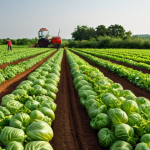It’s fascinating, isn’t it? The sheer romance of organic farming – the idea of working with the earth, cultivating healthy food, and truly making a difference.
I mean, who hasn’t scrolled through Instagram, seen those idyllic farm pictures, and thought, ‘Maybe that’s the life for me, a truly fulfilling career away from the rat race’?
But let’s be real for a moment: behind every sun-kissed tomato and perfectly tilled field lies a business, and like any profession, compensation varies wildly.
Especially now, with the explosion in consumer demand for sustainable practices and the ever-present challenges of climate change shaping agricultural markets, understanding the financial landscape of organic farming isn’t just about abstract curiosity; it’s absolutely crucial for anyone considering this path.
I’ve personally seen friends embark on this journey, some thriving financially, others struggling to find their footing despite their passion. It really makes you wonder about the actual numbers, doesn’t it?
Let’s dive deeper below to get the full picture.
It’s fascinating, isn’t it? The sheer romance of organic farming – the idea of working with the earth, cultivating healthy food, and truly making a difference.
I mean, who hasn’t scrolled through Instagram, seen those idyllic farm pictures, and thought, ‘Maybe that’s the life for me, a truly fulfilling career away from the rat race’?
But let’s be real for a moment: behind every sun-kissed tomato and perfectly tilled field lies a business, and like any profession, compensation varies wildly.
Especially now, with the explosion in consumer demand for sustainable practices and the ever-present challenges of climate change shaping agricultural markets, understanding the financial landscape of organic farming isn’t just about abstract curiosity; it’s absolutely crucial for anyone considering this path.
I’ve personally seen friends embark on this journey, some thriving financially, others struggling to find their footing despite their passion. It really makes you wonder about the actual numbers, doesn’t it?
Let’s dive deeper below to get the full picture.
The Unseen Investment: Seed-to-Sale Operational Realities

When you first dream of starting an organic farm, your mind probably leaps to rows of vibrant vegetables, the smell of fresh earth, and perhaps a friendly market stall. What often gets overlooked, and what truly took me by surprise when I started digging into the specifics, are the substantial upfront and ongoing costs. It’s not just about buying a patch of land; it’s about meticulously preparing that land, investing in specialized equipment, and ensuring compliance with stringent organic standards. I remember one conversation with a farmer who laughed, saying, “People think we just throw seeds in the ground and wait for money to grow!” The reality is far more complex and financially demanding, requiring careful planning and a robust understanding of agricultural economics.
1. Breaking Down the Upfront Investment in Organic Farming
Embarking on an organic farming venture typically begins with a significant financial outlay. Beyond the purchase or lease of land, which can vary astronomically depending on location and acreage, there are the initial infrastructure costs. Think about a proper irrigation system – essential for consistent yields, especially with unpredictable weather patterns – and this isn’t a small expense. Then there’s the necessary farm equipment: tractors, cultivators, planters, and harvesting tools, all of which need to be maintained or replaced. For organic growers, there’s often a need for specialized equipment that minimizes soil disturbance or helps with natural pest control, adding another layer of expense. I’ve seen firsthand how these initial investments can stretch a budget to its breaking point, and it’s a critical early hurdle that truly tests one’s resolve and financial preparedness. It’s not just a matter of ‘buying cheap’; quality tools mean less breakdown and greater efficiency in the long run.
2. Navigating Ongoing Operational Expenses and Unexpected Hurdles
Once the initial setup is complete, the financial demands don’t magically disappear. Organic farming, by its very nature, often requires more intensive labor and specific inputs compared to conventional methods. Weeding, for example, frequently relies on manual labor or mechanical cultivation rather than chemical herbicides, leading to higher labor costs. Then there are the organic-certified seeds and amendments, which can often be pricier than their conventional counterparts. Pest and disease management, without synthetic pesticides, often involves purchasing beneficial insects, traps, or specialized organic sprays, all of which contribute to the bottom line. Utilities, fuel, repairs, insurance, and the relentless cost of marketing your produce – it all adds up. It’s like a never-ending cycle of expenses, and any seasoned farmer will tell you that budgeting for the unexpected, like a sudden crop failure or a market downturn, is not just wise, it’s absolutely essential for survival. I’ve personally seen a friend’s entire season’s profit wiped out by an unseasonable hailstorm, underscoring the constant vulnerability farmers face.
Cultivating Revenue: Diverse Income Streams for Organic Growers
The beauty of organic farming, from a business perspective, lies in its inherent potential for diversification. While selling produce might seem like the obvious path, successful organic farmers rarely put all their eggs in one basket. They creatively tap into multiple income streams, building resilience against market fluctuations and natural setbacks. I recall a conversation with a farmer in Vermont who, after a particularly bad year for tomatoes, managed to stay afloat because of his robust CSA program and his thriving value-added product line. It was a powerful lesson in not just growing food, but growing a multi-faceted business that can weather the storms, literal and metaphorical.
1. Community Supported Agriculture (CSA) Models: Building Loyalty and Upfront Capital
One of the most foundational and financially stabilizing models for organic farms is the Community Supported Agriculture (CSA) program. This ingenious system allows consumers to purchase “shares” of a farm’s harvest at the beginning of the growing season, providing farmers with crucial upfront capital when expenses are highest. In return, members receive a regular supply of fresh, seasonal produce throughout the harvest period. It’s a win-win: farmers get financial security and a guaranteed market, while consumers get fresh, local, and often unique produce directly from the source. From my own experience working with local farms, the sense of community and connection that CSAs foster is invaluable; it creates a loyal customer base that truly feels invested in the farm’s success, which translates to a more stable and predictable income flow. This model also significantly reduces marketing costs because word-of-mouth becomes a powerful driver.
2. Farmers’ Markets & Direct-to-Consumer Sales: The Power of Personal Connection
There’s an undeniable charm and, more importantly, significant profit potential in direct-to-consumer sales, primarily through farmers’ markets. These vibrant hubs allow organic farmers to connect directly with their customers, build relationships, and, crucially, capture a larger share of the retail price that would otherwise go to distributors or grocery stores. I’ve always found the direct feedback from customers at a market incredibly rewarding and insightful – it’s where you truly learn what people want and what they value. Beyond farmers’ markets, many farms now operate their own farm stands, online stores, or even delivery services, further expanding their reach and eliminating intermediaries. While these channels require time for marketing and sales, the higher margins often make the effort well worth it, especially for specialized or niche organic products.
3. Wholesale & Restaurant Partnerships: Scaling Your Reach
For organic farms looking to scale their operations and distribute larger volumes of produce, wholesale partnerships with grocery stores, co-ops, and restaurants become vital. While the per-unit profit margin might be lower than direct sales, the sheer volume can make up for it, providing a consistent and substantial income stream. Building strong relationships with chefs who prioritize fresh, local, and organic ingredients can be particularly lucrative, as they often commit to consistent orders and are willing to pay a premium for quality and reliability. Navigating the logistics of wholesale – consistent supply, packaging standards, and delivery schedules – requires careful planning, but it’s a proven path to expanding an organic farm’s financial footprint. I’ve witnessed farms transform from small operations to major regional suppliers by securing just a few key restaurant contracts, truly showing the power of these partnerships.
The Green Gold Rush: Understanding Revenue Streams and Profitability
Peeling back the layers of organic farming, it becomes clear that profitability isn’t a given; it’s a meticulously crafted outcome influenced by a myriad of factors. It’s less about a single ‘salary’ and more about the intricate dance of diversified revenue streams, smart cost management, and market savvy. I’ve often heard people say, “Organic food is expensive, so farmers must be rich!” and I always have to gently correct them. While organic produce commands higher prices, the costs of production are also significantly elevated, meaning the profit margins can be surprisingly thin. It’s a testament to the farmer’s ingenuity and hard work when they manage to turn a true profit from the land.
1. Factors Influencing Your Bottom Line: Location, Scale, and Specialization
The profitability of an organic farm is profoundly shaped by its geographical location, the scale of its operation, and its degree of specialization. A farm located near a densely populated urban center with a high demand for local, organic produce will generally have better market access and potentially higher prices than one in a rural area with fewer consumers. Similarly, the scale matters: a small market garden might yield a decent per-acre profit, but a larger diversified farm could generate more substantial overall revenue, albeit with greater management challenges. Specialization also plays a huge role; a farm focusing on high-value, niche crops like gourmet mushrooms, rare herbs, or heirloom varieties might achieve higher margins than one growing commodity crops, even organically. However, this also carries higher risks if market demand shifts. It’s a constant balancing act, and I’ve seen farmers pivot their entire crop plan based on changing local tastes or emerging culinary trends, highlighting the dynamic nature of this business.
2. Value-Added Products: Turning Surplus into Profit
Perhaps one of the most effective strategies for boosting profitability and reducing waste in organic farming is the creation of value-added products. This involves taking raw produce and transforming it into something with a higher market value and a longer shelf life. Think jams, jellies, sauces, pickles, dried herbs, fermented vegetables like kimchi or sauerkraut, and even artisanal baked goods using farm-grown ingredients. Not only do these products command higher prices, but they also provide a way to utilize surplus produce that might otherwise go to waste, reducing loss and increasing overall farm income. I’ve visited farms where the value-added kitchen generates more consistent profit than the fields themselves, especially during off-peak seasons. It requires creativity, a solid understanding of food preservation, and often additional certifications, but the payoff can be substantial, transforming a bumper crop into year-round income.
| Revenue Stream | Description | Typical Profit Margin (Estimate) | Pros | Cons |
|---|---|---|---|---|
| Community Supported Agriculture (CSA) | Members pre-pay for a share of the harvest. | 25-40% | Upfront capital, loyal customer base, reduced marketing. | Requires strong community engagement, production consistency. |
| Farmers’ Markets / Direct-to-Consumer | Selling directly to consumers at markets or farm stands. | 30-50% | Higher retail prices, direct feedback, brand building. | Time-intensive, weather-dependent, requires sales skills. |
| Wholesale to Grocers/Restaurants | Selling in bulk to businesses. | 10-25% | Consistent large orders, expands reach, less direct sales effort. | Lower per-unit price, demanding quality and volume requirements. |
| Value-Added Products | Processing raw produce into higher-value goods (jams, sauces). | 40-60% | Utilizes surplus, higher profit margins, year-round income potential. | Requires processing equipment, additional certifications, marketing. |
| Agritourism / Events | Farm tours, workshops, weddings, festivals. | Variable (potentially high) | Diversified income, public engagement, brand awareness. | Time-consuming, requires visitor facilities, insurance considerations. |
The Unpredictable Seasons: Battling Challenges and Building Resilience
If there’s one constant in farming, it’s unpredictability. And for organic farmers, who intentionally forego many of the tools conventional agriculture uses to mitigate risk, this unpredictability can feel even more pronounced. I remember visiting a farm after an unexpected late-spring frost had wiped out an entire row of early berries, and the heartbreak in the farmer’s eyes was palpable. It’s a stark reminder that even with the best planning, nature holds the ultimate trump card. Understanding these challenges isn’t just about empathizing with farmers; it’s about recognizing the inherent risks that directly impact their financial viability and how they build in layers of resilience to survive.
1. Climate Change and Weather Volatility: The Farmer’s Constant Battle
Climate change isn’t just an abstract concept for organic farmers; it’s a daily reality that directly impacts their livelihood. We’re seeing more extreme weather events – prolonged droughts followed by intense floods, unseasonably warm winters, and sudden, devastating hailstorms. These unpredictable patterns wreak havoc on crop cycles, leading to reduced yields, increased disease pressure, and even total crop failures. Organic farmers, who rely on the natural balance of their ecosystems, are particularly vulnerable when these balances are disrupted. Adapting to this new climate normal requires constant innovation, from investing in resilient crop varieties to implementing advanced water management systems, all of which add to the operational costs. It’s a constant, exhausting battle against forces far beyond their control, and it demands incredible flexibility and foresight.
2. Pests, Diseases, and Soil Health: Organic Solutions and Their Costs
Managing pests and diseases without synthetic chemicals is a cornerstone of organic farming, but it’s also a significant financial and labor challenge. Organic solutions often involve a multi-pronged approach: fostering beneficial insect populations, rotating crops diligently, selecting disease-resistant varieties, and meticulously monitoring fields for early signs of trouble. This hands-on approach is labor-intensive and requires deep ecological knowledge. A severe pest outbreak can decimate an entire crop, and without chemical intervention, the recovery can be slow and expensive. Maintaining optimal soil health, the foundation of organic fertility, also requires continuous investment in compost, cover crops, and soil amendments. These practices are excellent for long-term sustainability but represent ongoing costs that contribute to the higher price point of organic produce and the farmer’s overhead.
Beyond the Farm Gate: Grants, Subsidies, and Support Systems
It’s easy to feel overwhelmed by the financial demands of organic farming, but it’s crucial to remember that farmers aren’t entirely alone in this endeavor. There’s a surprising array of grants, subsidies, and support systems designed to help organic growers overcome initial hurdles, adopt sustainable practices, and even buffer against market shocks. I’ve often seen how a timely grant can make the difference between a struggling start-up farm and one that flourishes, enabling them to invest in necessary equipment or expand their operations. Navigating this landscape of aid can be daunting, but it’s an absolutely vital part of the financial puzzle.
1. Navigating Government Programs and Organic Certifications
Governments, at both federal and state levels, often offer various programs to support agricultural producers, and organic farmers are increasingly becoming a focus. These can include cost-share programs for organic certification (which itself can be an expensive, multi-year process), conservation grants for implementing environmentally friendly practices, and even low-interest loans for farm expansion or equipment purchases. Understanding the eligibility criteria, application processes, and reporting requirements for these programs can be complex and time-consuming – almost a full-time job in itself! However, the financial relief they offer can be substantial, helping to offset some of the higher costs associated with organic production and certification. It requires diligence, but the rewards are often worth the paperwork.
2. Non-Profit and Community-Based Funding Opportunities
Beyond government aid, a vibrant network of non-profit organizations and community-based initiatives often provides invaluable support to organic farmers. These groups might offer grants for specific projects like soil health improvements, water conservation, or even marketing assistance for new farmers. Sometimes, they facilitate land access programs or provide mentorship and educational resources that indirectly contribute to financial success by improving efficiency and knowledge. I’ve personally seen crowdfunding campaigns successfully launch new organic farms or help existing ones recover from unexpected disasters, demonstrating the powerful role that community support can play. Tapping into these local and regional networks isn’t just about financial aid; it’s about building a supportive ecosystem that can sustain a farm through challenging times.
The Human Element: Labor, Lifestyle, and Personal Investment
When we talk about the ‘profitability’ of an organic farm, it’s incomplete without addressing the compensation of the farmer themselves. This isn’t just a business, it’s often a lifestyle, a calling, and an immense personal investment. The notion of ‘farmer’s salary’ can be a tricky one, as much of what they earn often gets reinvested into the farm, and their ‘wage’ is intertwined with the farm’s overall success. I’ve known farmers who’ve poured their entire savings, their physical energy, and their waking hours into their land, sometimes taking very little personal income in the early years. It’s a stark reminder that while the dream is idyllic, the dedication required is monumental.
1. The True Cost of Labor: Hiring, Training, and Retention
Labor is one of the most significant line items on an organic farm’s budget. Unlike conventional farms that might utilize heavy machinery or herbicides to reduce manual labor, organic methods often demand more hands-on work – weeding, careful harvesting, pest scouting, and intricate soil management. Finding skilled, reliable farmhands who understand organic principles can be a challenge, and retaining them requires fair wages, decent working conditions, and sometimes even benefits. I’ve seen farmers struggle immensely with staffing, particularly during peak seasons, and the costs associated with recruitment, training, and complying with labor laws can quickly erode profit margins. It’s a delicate balance between needing enough help to get the work done efficiently and affording that help without bankrupting the farm. Many organic farmers also dedicate substantial hours of their *own* unpaid labor, effectively subsidizing their operations.
2. The Farmer’s Salary: What You Can Realistically Expect for Your Efforts
So, what does an organic farmer actually make? The honest answer is: it varies wildly. In the initial years, many organic farmers, especially those starting small, might earn very little – sometimes even less than minimum wage when accounting for their hours, or even operate at a loss. Much of the farm’s revenue often goes back into operating expenses, debt repayment, and reinvestment. Experienced, established organic farmers with diversified income streams, good market access, and efficient operations can certainly achieve a comfortable living wage, and some even high incomes, but it often takes years of hard work, smart business decisions, and a bit of luck. It’s less about a fixed salary and more about the farm’s overall profitability, and the farmer’s share of that profit. What I’ve personally observed is that passion for the land and the desire to produce healthy food often fuel these individuals more than the immediate financial return, especially in the early, lean years.
The Future of Farming: Innovation and Sustainable Growth Strategies
The landscape of organic farming is constantly evolving, driven by consumer demand, technological advancements, and the urgent need for sustainable food systems. For organic farmers looking not just to survive but to thrive and grow their income, embracing innovation is no longer optional; it’s a necessity. From adopting cutting-edge technologies to strategically planning for the long term, these approaches are shaping the future of financial viability in the organic sector. I believe that those who are open to adapting and learning new methods will be the ones who truly reap the rewards in the coming decades, both environmentally and economically.
1. Embracing Technology: Smart Farming for Organic Growers
While organic farming emphasizes natural processes, it doesn’t mean shunning technology. In fact, smart farming technologies are becoming increasingly vital for optimizing efficiency and reducing costs, even for organic operations. This includes precision irrigation systems that minimize water waste, sensor networks that monitor soil health and crop conditions, and even drone technology for mapping fields and identifying pest hotspots early. While the initial investment in some of these technologies can be significant, the long-term savings in labor, water, and inputs, combined with increased yields, can dramatically improve a farm’s bottom line. I’ve seen small farms utilize simple apps for inventory management and sales tracking that have revolutionized their efficiency, demonstrating that ‘tech’ doesn’t always mean massive robots; sometimes it’s just about smarter information management.
2. Succession Planning and Long-Term Farm Viability
A truly successful organic farm isn’t just about maximizing annual profits; it’s about building a legacy and ensuring long-term viability. This includes crucial aspects like succession planning – thinking about who will take over the farm in the future, whether it’s family or new farmers, and how knowledge and assets will be transferred. It also involves continuous investment in soil health and ecosystem services, which might not yield immediate financial returns but are absolutely critical for the farm’s productivity for generations to come. Developing robust business plans, diversifying revenue streams, and building strong relationships with the community and local markets are all part of this long-term vision. It’s a holistic approach to farming that recognizes the intrinsic link between ecological health, community well-being, and sustainable financial success, ensuring that the farm can continue to provide for both the land and its caretakers far into the future.
Wrapping Up
So, is organic farming profitable? The honest answer is: it’s incredibly complex, deeply challenging, but absolutely rewarding for those who persevere.
It’s not a get-rich-quick scheme, but rather a journey that demands unwavering passion, sharp business acumen, and a deep respect for the land. While the financial returns can be unpredictable, the satisfaction of growing healthy food, building community, and contributing to a sustainable future is, for many, the ultimate harvest.
It’s a testament to human resilience and ingenuity, constantly adapting to nature’s whims and market demands.
Useful Information to Know
1. Conduct thorough market research: Before planting, understand what local consumers and restaurants are demanding. Niche crops can offer higher margins.
2. Network with experienced organic farmers: Learning from those who’ve navigated the challenges and found success is invaluable. Join local farming associations or online communities.
3. Actively seek out grants and support programs: Don’t underestimate the financial aid available from government agencies and non-profit organizations. It takes time, but it can be a game-changer.
4. Prioritize soil health from day one: Healthy soil is the bedrock of organic productivity and long-term profitability, reducing the need for costly external inputs.
5. Start small and scale strategically: While tempting to go big, many successful organic farms begin on a smaller scale, learning the ropes and building market relationships before expanding.
Key Takeaways
Organic farming is a significant investment of time, labor, and capital, and profits are rarely immediate or guaranteed. Success hinges on a diversified income strategy, blending direct-to-consumer sales, wholesale, and value-added products to mitigate risk and maximize revenue. Farmers face inherent challenges from unpredictable weather and pest pressures, but various government and community support systems exist to help. Ultimately, while financial outcomes vary widely, a blend of passion, business acumen, and adaptability is essential for building a thriving and sustainable organic farm.
Frequently Asked Questions (FAQ) 📖
Q: What’s the typical income for an organic farmer, really? Is it enough to live on?
A: Honestly, this is the million-dollar question, and it’s rarely a straight answer. From what I’ve observed and heard directly from folks actually out there in the fields, the income can swing wildly.
You’ve got your small-scale, direct-to-consumer operations where a dedicated farmer might pull in anywhere from, say, $30,000 to $60,000 annually after expenses, especially if they’re good at marketing their CSA shares or farmers’ market stalls.
Then you have larger, more established organic farms supplying grocery chains or wholesale markets; those operations can see revenues in the hundreds of thousands, but their overheads are enormous – think big land leases, specialized equipment, significant labor costs.
I’ve even seen urban organic farmers make a decent living on just a few acres, leveraging high-value crops like specialty greens. It truly depends on so many variables: your location, your market, what you’re growing, and frankly, how savvy you are on the business side.
It’s definitely not a get-rich-quick scheme, but for many, it provides a comfortable, albeit often demanding, lifestyle.
Q: Beyond the romantic appeal, what are the biggest financial hurdles an aspiring organic farmer actually faces?
A: Oh, where do I even begin? That idyllic Instagram picture rarely shows the mountain of initial capital you need. Land, for starters, is eye-wateringly expensive, and good organic land is even harder to come by.
Then there’s the cost of equipment – tractors, irrigation systems, processing tools – that stuff adds up faster than you can say ‘biodiversity.’ Beyond that, getting your organic certification isn’t just a paper exercise; it often means a few years of transitioning land (which means no organic premium during that time!), plus ongoing fees and inspections.
And let’s not forget the elements! A single unexpected frost or a relentless drought can wipe out a season’s worth of income, and insurance doesn’t always cover everything.
It’s a constant tightrope walk between managing inputs and hoping Mother Nature cooperates. I’ve heard too many stories of folks pouring their life savings into it, only to be knocked back by an unforeseen hurdle.
Q: Given these challenges, what really differentiates the organic farmers who financially ‘thrive’ from those who struggle?
A: That’s the crux of it, isn’t it? From my vantage point, and watching friends go through it, it often boils down to a blend of shrewd business sense and incredible resilience.
The ones who thrive usually aren’t just great growers; they’re brilliant marketers. They understand their local market inside out – whether it’s setting up a successful CSA (Community Supported Agriculture) program, building strong relationships with local restaurants, or excelling at farmers’ markets.
They diversify their crops, so if one fails, they’ve got others to fall back on. They’re not afraid to innovate, whether it’s using vertical farming for high-value greens or adopting permaculture principles to reduce inputs.
And perhaps most critically, they’ve got that grit. When a crop fails or prices drop, they don’t give up; they pivot, they learn, they hustle. It’s less about a magic bullet and more about a persistent, adaptive approach to both farming and business.
📚 References
Wikipedia Encyclopedia
구글 검색 결과
구글 검색 결과
구글 검색 결과
구글 검색 결과
구글 검색 결과



